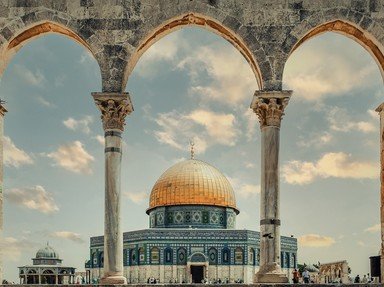Quiz Answer Key and Fun Facts
1. We will begin our bus tour of Israel in Eilat, a beach resort and port located at Israel's southern tip. What body of water does Eilat border?
2. We re-board our bus and travel north for about half an hour, until we reach a rest stop at Kibbutz Yotvata. In addition to stretching our legs and having a cold drink, we will visit the Hai Bar, located adjacent to the kibbutz. But what exactly is a Hai Bar?
3. Continuing our journey north, we reach the town of Mitzpe Ramon and a geological formation called a "maktesh". Since this is a unique formation, the Hebrew term "maktesh" is used universally. However, what type of formation does a "maktesh" most closely resemble?
4. A voice is heard from a passenger on the bus. "Since we arrived in Israel, we haven't left the desert! I'd like to visit the city where I can hear the Israeli Philharmonic play in their own hall (especially if Zubin Mehta is conducting) and I'd like to see a performance of the Israeli Opera in the Opera House. I wouldn't object to dining in a fine restaurant, either". "No problem" says our guide, "We'll head straight for the White City." Which Israeli city will the bus visit next?
5. We'll continue our journey northward toward Zichron Yaakov, where the Carmel Mountain range begins. The Carmel Forest is recognized by the United Nations as a bioreserve, an honor given to only five-hundred places on the planet. What feature makes it unique among bioreserves?
6. Oh no! While taking a short hike through the Carmel Forest, one of the Funtrivia passengers trips and twists her ankle. "We'll have to take you to the hospital to have that treated" says the tour guide. "I'm a little nervous about being treated in a foreign hospital" says our patient, "What standard of health care can I expect to find?" What is NOT true about the care provided in a public hospital in Israel?
7. A still small voice is heard from the back of the bus. It is Logcrawler. "I was looking forward to seeing some of the important Christian holy places in Israel." "No problem" announces our always up-beat guide. "If we begin at Zichron Yaakov and travel about twenty-five kilometers north-east, and then drop south on route 77 for about ten kilometers, we'll reach a very important Christian pilgrimage site". What site will we reach, if we follow our guide's directions?
8. We leave Zippori bright and early in the morning and head east towards Hamat Gader. "I have a special treat in store for you at Hamat Gader" says our tour guide. What fun activity will we be enjoying at our next stop?
9. Our next stop is Degania Aleph, on the shores of the Sea of Galilee. Why is Degania Aleph famous?
10. We've saved the best for last! Heading south through the Jordan Valley, which is part of the Great African-Syrian Rift, we will soon be arriving in Jerusalem! On the way we will stop at Moshav Argamon and sample some of the delicious goat cheeses made by Frieda and Abba Tessler. As we turn right and begin our ascent to Jerusalem, a crowd on the bus bursts out with that old favorite, "Twelve Gates to Jerusalem". The bus driver informs us that we will be parking the bus close to David's Citadel. If so, though which gate will we enter the city?
Source: Author
janetgool
This quiz was reviewed by FunTrivia editor
Pagiedamon before going online.
Any errors found in FunTrivia content are routinely corrected through our feedback system.
